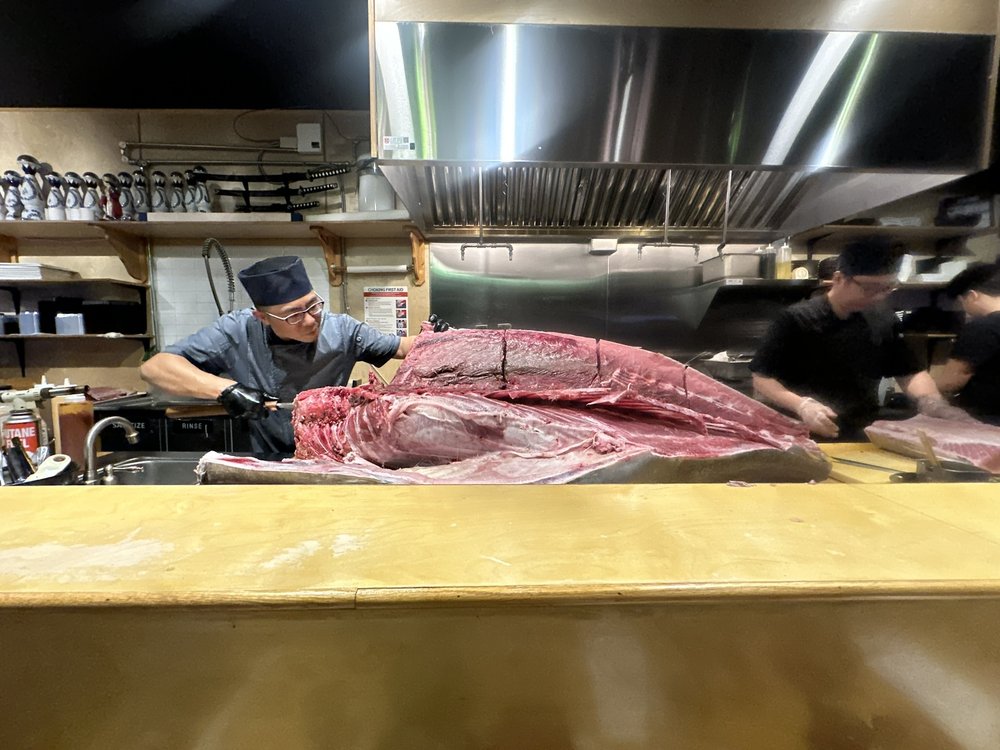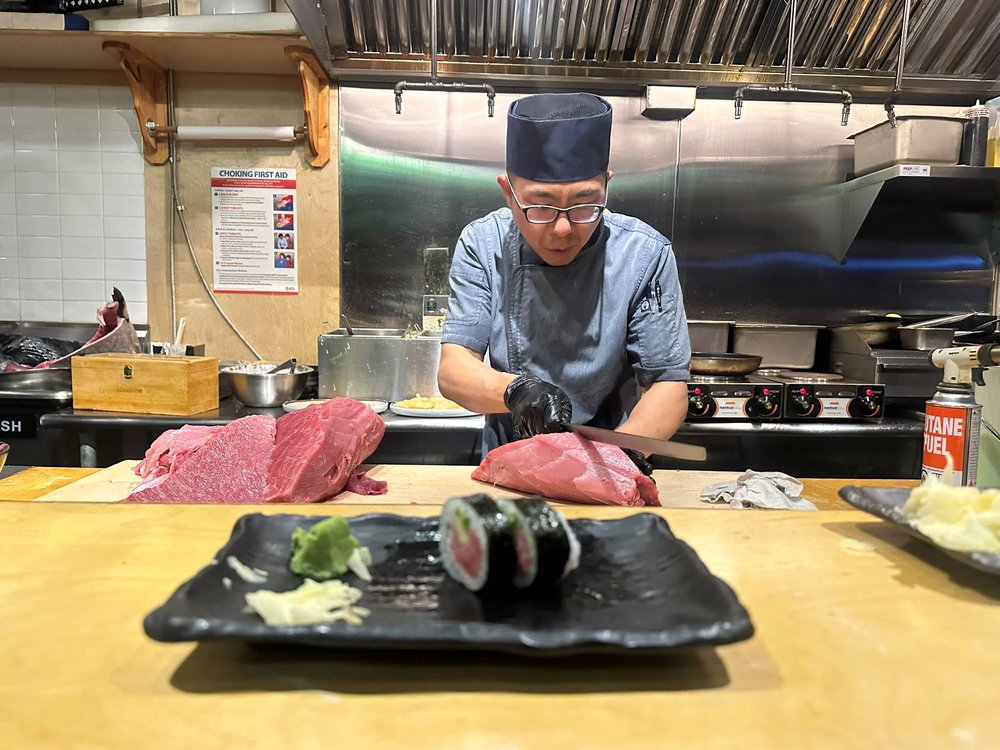A South Brooklyn sushi spot is selling out every Monday. It’s the tuna carving.
June 5, 2025, 12:20 p.m.
New York City's omakase restaurants are having a moment.

It can take weeks to land a coveted Monday night seat at the counter of Koma Sushi in Midwood, where it takes five sushi chefs just to carry out the main attraction: a 400-pound tuna fish.
On a recent Monday, the crowd oohed and aahed as the chefs displayed the impressive catch. Most pulled out their cell phones to capture the massive fish. Cheers rang through the restaurant as one of the chefs announced that the catch was the largest in the restaurant’s history.
Koma's popularity has been fueled by social media, where videos of its chefs carving enormous fish have made the rounds. Koma is also among a growing number of New York City eateries serving omakase — or "chef's choice" — style meals.
The sushi chefs and two other staff members immediately got to work slicing open the fish, which was also that evening’s dinner.
Once the fanfare had died down, patrons sat to nibble on edamame and miso soup as they awaited the second part of the evening: the omakase-style meal, where chefs doled out the best slices.

Blue bottles of icy sake were placed next to every seat in the restaurant; the $125 all-you-can-eat meal included unlimited sake. Conversations flowed throughout the room as each bottle was emptied.
Pieces of tuna were doled out to hungry patrons roughly 45 minutes before the tune carving show began at 7 p.m. Thin slices of the lean protein were served atop pockets of rice, nigiri-style, while others were covered in a soy glaze and topped with marinade.
At one point, a chef used a blow torch to char fatty pieces of tuna — also known as otoro — while diners were served traditional tuna maki rolls and handrolls.
The tuna carving meal has no formal end: The chefs just bring out sushi from the tuna until the restaurant closes at 11 p.m. Folks leave when they’re ready and settle up with the host waiting by the door.

Most diners called it quits after about three hours, though some stayed until closing time.
According to filings with the State Liquor Authority and the Department of State, Koma is owned by Azhdar Ragimov, who filed a liquor license permit alongside Elgar Ilyasov. When Gothamist tried to reach the owners for comment on this story, a woman answered the phone number listed for the restaurant but declined to give her name or speak on the record.
Some patrons at Koma wait weeks or even months for a seat, and it isn't the only spot to book so quickly. It’s easy to see why the cuisine is having a moment. Omakase – which loosely translates to “I leave it up to you” – is a chef’s choice style meal. In Japan, that can include most types of cuisine, but in the United States, it almost always involves sushi.
While the American obsession with sushi can be traced back to Japanese immigrants who arrived to the West Coast in the 1920s and ‘30s, omakase's popularity is fairly recent, according to Eric Rath, a history professor at the University of Kansas who has published several books on Japanese cuisine, including "Oishii: The History of Sushi."
“It solves the problem of what to order,” he said. “And from the chef’s standpoint? It lets them offer a set amount, and they know what they’re going to serve and how much.”
Rath said sushi first took off around the 1960s in Los Angeles and New York City, but its place in modern American pop culture was solidified after "Shogun," a 1980s TV show that was an explosive hit.
The phenomenon led historian Samuel Yamashita to coin the phrase “Japanese turn” to describe the cuisine’s popularity and influence in the United States, starting in the 1980s.
While some omakase experiences can last hours with seemingly infinite courses and cost customers hundreds or even thousands of dollars at the end of the night, most omakase spots are more affordable.
Restaurants like SourAji in Alphabet City are known for all-you-can-eat experiences where you can load on as many pieces of lean tuna, fatty tuna, eel or even wagyu beef as you can handle.
Shinn West in Hell’s Kitchen has been offering two omakase meals for the price of one for months while its second location finishes renovations, and Ume in Williamsburg presents the materials for an omakase meal and lets patrons design the courses themselves. And some spots – like Sushi On Me in Jackson Heights – play R&B and hip-hop in a dimly lit speakeasy as sushi chefs tell customers to “Enjoy your f---ing dinner!”
The appeal of sushi for most Americans, Rath said, can also be attributed to its health benefits, aesthetic quality and novelty. And the fact that it tastes so damn good.
Omakase provides the ability to experience a meal that’s been handpicked by an expert and features the freshest ingredients caught that week or even day, said Rath. And for sushi fans who feel stumped by the sheer volume of options available, omakase almost guarantees that you’ll have the menu's best items.
“It’s something special, it’s something that’s easy to order and it’s seasonal – it’s going to be different each time,” he said.
10 low-budget restaurants that are worth a detour to St. Mark’s Place NYC parents on school WhatsApp group chats: ‘Oh my God, it’s hell’ Meet the family that's been delighting Queens diners for almost 50 years